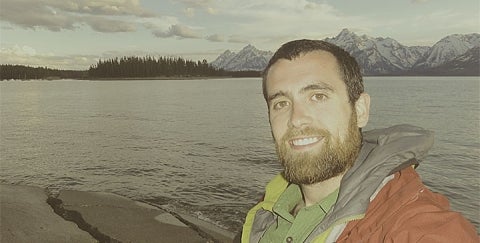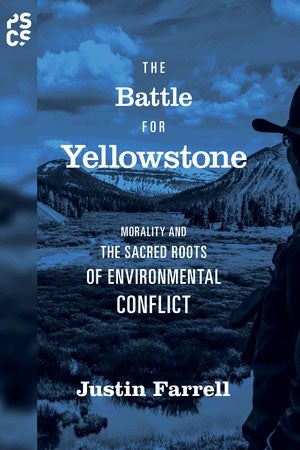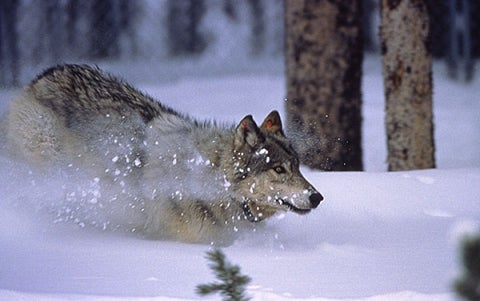Note: Yale School of the Environment (YSE) was formerly known as the Yale School of Forestry & Environmental Studies (F&ES). News articles and events posted prior to July 1, 2020 refer to the School's name at that time.

Perhaps no natural landscape within the U.S. is more revered than Yellowstone National Park. Yet nearly since its designation as the nation’s first national park, Yellowstone has also been the source of bitter and emotional conflict, including contentious debates over land use, wolf protection, bison management, and fracking.
In a new book, “
The Battle for Yellowstone: Morality and the Sacred Roots of Environmental Conflict,” Yale Professor
Justin Farrell makes the case that these conflicts, while often framed in scientific and economic terms, in truth have deeper cultural, moral, and spiritual roots. The book was called “The most original political book of early 2015” by
The Economist.
In an interview, Farrell explains some of the cultural and moral forces that fuel these conflicts, describes one crisis that was resolved after two very different groups were able to work together, and explains why Yellowstone still galvanizes such passion.
”Yellowstone is a symbol for so much more than just what’s happening inside those invisible boundaries,” says Farrell, an associate professor of sociology at the Yale School of Forestry & Environmental Studies. “And as our first national park, this is where this debate started. So there are many emotions charging it.
“It’s really just a touchstone for so many other important political issues.”

What made you want to study Yellowstone?
JUSTIN FARRELL: My family is from Idaho and Wyoming, and I was born in Cheyenne and grew up in Nebraska. So I’ve spent a lot of time in that area, and the issues I write about are issues I’ve thought about since I was young. One of my most memorable childhood experiences was watching as a resort company built a small hotel next to my grandfather’s old cabin. And over the years I just saw more and more development occur in the region.
And these issues I write about — the conflicts over wolves, bison, and fracking — are also in the news quite a lot. I wanted to become more familiar with these issues and better understand what’s going on out there. I found that there is a lot of discussion about natural science and economics, and the technical ways to resolve disagreements — which is great. But as a sociologist, I felt that there was a gaping hole in terms of understanding the actual roots of these disagreements, which as I show in the book are not techno-rational, but are moral and cultural.
What are the major conflicts facing the region?
FARRELL: The conflict over wolves, which has been raging for decades, is certainly one of the most contentious. Since wolves were reintroduced into the ecosystem in the mid-90s there has been much protest from ranchers who say that wolves are costing them too much money. And for a long time that’s what people thought the conflict was about — even those who are involved in the conflict. But, as I describe in the book, I found something much different.
Another one is the buffalo conflict, which is kind of a similar phenomenon in which the buffalo are roaming on to private property as they migrate out of the Park every year. And the government will basically herd them back into the Park. There’s a lot of disagreement over whether the government should just let the bison roam free. The argument against them roaming free is that they’ll spread the disease brucellosis to cattle, which hinges on a scientific question of how and whether the disease, can actually spread to cattle. One side says it cannot. The other side says, ‘Well, it can, but we’ve just prevented it through these pre-emptive actions.’
You mentioned that people misunderstand what the wolf conflict is really about. What have you found?
FARRELL: The wolves definitely kill livestock, but to make an economic argument that says they shouldn’t be there because of economic costs just doesn’t stand up. Yes, ranchers are losing some money, but if you compare that with how much money wolves bring in, including through tourism, it just doesn’t compare and many are compensated for their losses… Through interviews and observations with ranchers and anti-wolf folks, I found that it really wasn’t about money at all. It was about a non-native animal that was forcibly put there by the federal government, and that is now crossing onto private property. So it has more to do with private property rights, western sensibilities of independence, and the contentious relationship many in the West have with the federal government. I did a similar analysis on pro-wolf conservationists to understand their deeper cultural and moral motivations, beyond their surface level arguments concerning importance of apex predators, trophic cascades, or ecological wholeness.
In the political arena, however, the discussion always comes back to economic matters, or natural scientific, biology, and ecology. But we’re missing the engine that’s driving people to make these arguments in the first place. I’m not saying that we don’t need economic research or that it’s not important. Indeed, it is vital. Rather, I’m saying, let’s look at why people conduct this research or have certain beliefs in the first place. If you’re talking to conservationists, ask, Why do we even want wolves back? “Well, ecological wholeness.” OK, but why do we care about that? And you eventually drill down and get to a point where people will say, “Well, it’s just what I want. It’s what I believe.” And that’s fine, but let’s acknowledge it. In this book I do that with conservationists as much as I do with ranchers. And there are a lot of different groups and agencies with different interests in the region.
And they all have different visions of what this place should be...
FARRELL: Yes, and at times it can be a sort of powder keg of emotions and economic interests. And really this all intersects with cultural and normative ideals and the deeper foundational ideas and commitments that people have. For some it’s to a piece of land that they’ve ranched for several generations. And for others it’s about preserving a place in the United States where the human impact is not so noticeable — or for some, the desire to have no humans in the Park at all.
Has it been this way since Yellowstone was designated a national park?
FARRELL: Yes, I think it has. But since 1970 it’s gotten a lot worse because of the population growth. Some counties around the park are among the fastest growing in population and land development in the U.S., including around Jackson Hole and in some areas around Bozeman. Another major factor is the changes in environmental regulation — which, in my opinion, were obviously changes for the better. Before the 1970s there weren’t quite as many interests, organizations, and stakeholders. Things have definitely ramped up.
Was part of this ‘ramping up’ due to — and a reaction to — the emergence of the environmental movement?
FARRELL: Yes. The environmental movement brought some of these different laws that could be enforced, giving political and legal teeth to the sentiments some people had. And just as important, people started to move to these areas because they wanted to live near natural amenities. So now you had the conservation folks and you had the ‘natural amenities’ folks who were buying second homes — or third homes and fourth homes. And of course you have the “Old Westerners” — as I call them in the book — the people who had lived there for a long time.
 <span lang="en">A newly released wolf crashes through the snow in Yellowstone National Park.</span>
<span lang="en">A newly released wolf crashes through the snow in Yellowstone National Park.</span>
But even before that, Americans have always been fascinated with this region. Especially people from the East coast. In the chapter on wolves I describe how the public letters written in support of wolves came from all over the U.S., but that there were barely any written by people in the area. You’d see a letter written by someone in New York City: “The wolves in that region are amazing creatures…” and they’d use religious, and sometimes erotic, language to describe them. And then local people who opposed [wolves] would write, “Well, we have to deal with them everyday, so it’s easy for you to feel that way.” They’d write that they were afraid that their kids would get eaten by wolves, which isn’t true either. But there just are these cultural myths about wolves that play into the environmental conflict in real ways.
So do you see this as a conflict between the fundamentally different worldviews of locals and outsiders?
FARRELL: At its most basic level, I think you could lump them into two groups. But that also introduces its own problems because there are all sorts of shades of grey in there. And you always have new values established in the U.S., which is reflected in landmark new laws that jumpstart social changes… And a lot of the stuff that the old westerners were doing — including through wide-scale extraction — weren’t good for the land. Just because you did it for a long time doesn’t mean that you should still be permitted to do it.
Are there any examples in which the disparate groups were able to get beyond these deep-seeded tensions?
FARRELL: Yes, one example is fracking, which is the third major conflict I cover in the book. Fracking is occurring south of Jackson Hole — not in the Park proper, but within the bounds of the Greater Yellowstone Ecosystem. And the interesting thing about the case I write about in the book is that there was a plan to frack in the Hoback River area that was opposed by some of the same people who also don’t like wolves and tend to be pretty closed off to environmental regulation. It was an interesting case because the people who led this social movement were not involved in any sort of environmental work at all. In fact they oppose a lot of it. Interestingly enough, they were very concerned about being seen as tree-huggers and distanced themselves from a lot of environmental conservation folks.
The group was led by an ex-Marine who assembled a lot of the locals and he said, “We’re not going to have this here.” The group overtly drew on moral and spiritual claims. And they agreed to work with a conservation group that they thought was more moderate. But during the campaign they agreed not to talk about wolves, or buffalo, or snowmobiling. They said, “We’re just going to focus on this issue, and our common ground is that we’re deeply attached to this place.”
A lot of these people hunted in this area, so there was this deep, spiritual attachment based on generations that they described to me. This same attachment that led them to oppose wolves also led them to oppose fracking. It was a really interesting case in which they had to make sense of being environmentalists all of a sudden… And it was the fact that they used the moral and spiritual language that gave them a common voice with conservationists. They could agree with them on that, that it had some intrinsic value — and it worked. I don’t make any policy prescriptions in the book, but I use that example to show that maybe if we acknowledge these moral and cultural influence, and bring them to the surface, then we might have better luck.
Do you think people recognize how their personal moral and spiritual beliefs affect their actions when it comes to nature?
FARRELL: I was taken aback by how people were so unaware of these underlying influences. So many people assume that they’re operating at the level of fact concerning how things are and do not consider questions of values. What are the foundational ideals that motivate us in the first place? Those things tell us what a good life looks like, what we should do, and what kinds of people we should be. Every single person is informed by answers to these questions, and these answers come from the cultures in which we live. But people weren’t able to articulate that to me.
I think it would be helpful if we could reflect on those questions more. In this case, ask what does the wolf really mean to us? What does it symbolize? And how does that fit into our narrative of who we are as a people, a nation, a civilization? About our concern for future generations? About our role as humans in the evolutionary story? And so on. It’s all about identifying the cultural narratives that matter for people… These issues of cultural and morality have profound material, economic and scientific implications.
Why do Yellowstone and the conflicts occurring there resonate so strongly with so many people?
FARRELL: Yellowstone is a symbol for so much more than just what’s happening inside those invisible boundaries. You go to around the world and people know of Yellowstone. For Americans, it is important because we have expanded almost everywhere we can go. So some people say, let’s keep at least a handful of spaces off-limits. And as our first national park, this is where this debate started. So there are many emotions charging it. It’s really just a touchstone for so many other important political issues.


 <span lang="en">A newly released wolf crashes through the snow in Yellowstone National Park.</span>
<span lang="en">A newly released wolf crashes through the snow in Yellowstone National Park.</span>